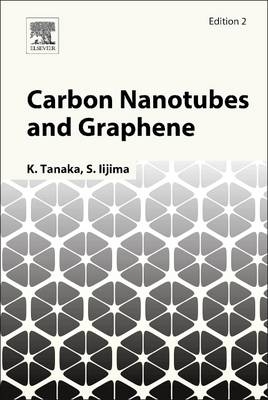
Carbon Nanotubes and Graphene
Elsevier / The Lancet (Verlag)
978-0-08-098232-8 (ISBN)
Carbon Nanotubes and Graphene is a timely second edition of the original Science and Technology of Carbon Nanotubes. Updated to include expanded coverage of the preparation, purification, structural characterization, and common application areas of single- and multi-walled CNT structures, this work compares, contrasts, and, where appropriate, unitizes CNT to graphene. This much expanded second edition reference supports knowledge discovery, production of impactful carbon research, encourages transition between research fields, and aids the formation of emergent applications. New chapters encompass recent developments in the theoretical treatments of electronic and vibrational structures, and magnetic, optical, and electrical solid-state properties, providing a vital base to research. Current and potential applications of both materials, including the prospect for large-scale synthesis of graphene, biological structures, and flexible electronics, are also critically discussed.
Kazuyoshi Tanaka received a doctorate of Engineering degree from Kyoto University in 1978 under the guidance of late Professor Kenichi Fukui who was a co-laureate of Nobel Prize in chemistry in 1981 with Professor Roald Hoffmann in Cornell University. A postdoctoral fellow of JSPS (1978-1979) and had joined in a US company (Energy Conversion Devices, Inc. in Michigan) from 1979 until 1981. He returned to Faculty of Engineering, Kyoto University in 1981 as a Research Associate (1981-1988), and then was promoted to Associate Professor (1988-1996) and Professor in the Department of Molecular Engineering, Graduate School of Engineering, Kyoto University from 1996. Tananka was a leader of the CREST team, JST, from 2002 to 2007 sponsored by the Ministry of Education of Japan, with the research theme of “Nanoelectronic-Device Fabrication Based on the Fine Molecular Design. After earning a degree in physics at Tohoku University in Sendai, Japan, Sumio Iijima moved to Arizona State University as a post-doctoral associate where he initiated high-resolution transmission electron microscopy (HRTEM) (1970-1982). Using the technique, he has brought a new type of information of local atomic structures of crystals into condensed matter physics, solid state chemistry, crystallography, mineralogy and materials science. Ample experiences with the different types of materials including nanostructures of carbon materials have led him to discover carbon nanotubes in later years. In these days the technique has been known as the most powerful one in the research fields of nano-materials science and nanotechnology. In 1982 he returned to Japan and worked for 5 years on a national ERATO project on nano-particles, then joined the NEC fundamental research laboratories. In 1991 he discovered carbon nanotubes that have initiated nano-materials science and nanotechnology and has being attracted world-wide researchers in academia and industry. Following the discovery, he has been honored with numerous awards and prizes that include: Franklin Medal in physics (2001), Agilent Europhysics award (2002), Balzan Prize (2007, Italy-Switzerland), Kavli Prize (Norway, 2008), Prince of Asturias Award (Spain, 2008), Order of Culture (Japan, 2009), He is members of Foreign Associate of the National Academy of Science (USA. 2007), the Norwegian Academy of Science and Letters (2009), member of Japan Academy (2010) and foreign member of Chinese Academy of Sciences (2011).
1. Preface 2. Positioning of Carbon Nanotubes and Graphene in Carbon Allotropes and Their Comparison 3. Preparation of High-Quality Carbon Nanotubes 4. Differentiation of Carbon Nanotubes with Different Chirality 5. Preparation of Graphene with Large Area 6. Electronic Structures and Band Structures of Carbon Nanotubes and Graphene 7. Optical Response of Carbon Nanotubes and Graphene 8. Phonon Structures and Raman Effect of Carbon Nanotubes and Graphene 9. Transport Properties in Carbon Nanotubes and Graphene 10. Mechanical Properties of Carbon Nanotubes and Graphene 11. Chemical Reactivity and Surface Activity of Carbon Nanotubes and Graphene 12. Preparation and Properties of Carbon Nanotube Peapod 13. Processing Technology for Carbon Nanotubes and Graphene toward Application 14. Electronics Application of Carbon Nanotubes and Graphene 15. Spin Electronics Application of Carbon Nanotubes and Graphene 16. Biological Application of Carbon Nanotubes and Graphene 17. Characteristics and Applications of Carbon Nanotubes with Different Numbers of Walls 18. Characteristics and Applications of Graphene with Different Numbers of Stacked Sheets 19. Graphene Nanoribbon and Nanographene 20. Application of Hybrid Composites Using Carbon Nanotubes or Graphene
| Verlagsort | London |
|---|---|
| Sprache | englisch |
| Maße | 152 x 229 mm |
| Gewicht | 800 g |
| Themenwelt | Technik ► Maschinenbau |
| ISBN-10 | 0-08-098232-8 / 0080982328 |
| ISBN-13 | 978-0-08-098232-8 / 9780080982328 |
| Zustand | Neuware |
| Informationen gemäß Produktsicherheitsverordnung (GPSR) | |
| Haben Sie eine Frage zum Produkt? |
aus dem Bereich


